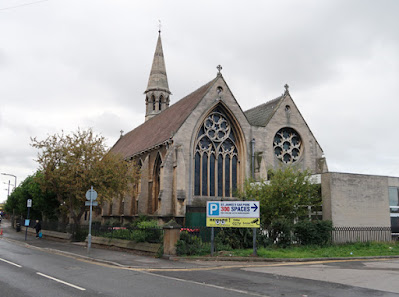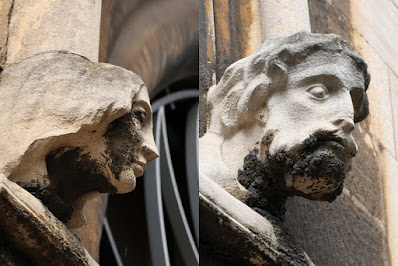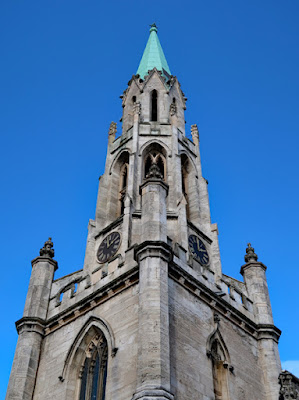Continuing my day out in Doncaster, having briefly explored Cusworth and the grounds of Cusworth Hall, I photographed the Grade II Listed Keeper’s Cottage and the former Church of St. Edmund, a C18 agricultural building that was converted into a church by George Pace in 1954, before walking back into Doncaster.
 |
| The former Church of St. Edmund |
Once back in Doncaster, my task for the afternoon was to photograph 15 buildings for the British Listed Buildings Photo Challenge, of which only St. James’ church (1858) on St. Sepulchre Gate West is built in stone and are not of particular interest to this Language of Stone Blog.
It was built by shareholders of the Great Northern Railway and was designed by Sir George Gilbert Scott in conjunction with Lord Grimthorpe, the son of the chairman of shareholders, Sir Edmund Beckett. In a very uncharacteristic addition to his description of the church, Pevsner refers to him as a ‘venomous, pompous, righteous bully of St. Albans notoriety’.
I had passed by this church many times when arriving in Doncaster from the Rotherham on the bus and train, without ever thinking of taking a closer look at it and, judging by its cream coloured stonework, presumed that it was built with Permian dolomitic limestone from the Cadeby Formation - the building stone that is almost exclusively used in and around Doncaster.
Arriving at the very dirty south porch, however, I immediately thought that the dark brown colour of the patina and dirt was more typical of Jurassic oolitic limestone than Magnesian Limestone. The distinctive ripple marks in the stone used for the shafts confirmed to me that this is Ancaster limestone, which is also recorded in the Historic England listing description.
After taking photographs of the headstops to the porch, which are partly covered in clinker like deposits that typically contain damaging concentrations of sulphates, I walked round to the north elevation to photograph the separately listed iron railings.
Here, in the car park that once formed part of the railway sidings, the tarmac has worn away to reveal setts that are made of the very distinctive markfieldite, a microdiorite that has green hornblende and pink feldspar as major mineral components and has been extensively used throughout the UK for ballast upon which railway tracks are laid.
I then made my way along Waterdale to Hall Cross Hill, where I stopped briefly to look at Hall Cross (1793), built with coarse cross-bedded dolomitic limestone, before going to find various listed buildings to photograph in the Georgian district of Doncaster.
Reaching the churchyard at the Grade II* Christ Church (1829), I took a few photos of the gatepiers and railings and then had a very quick walk around the exterior, which according to the church website is built in Roche Abbey stone, to take a few general photos for my own records.
The church was designed in a Commissioners Gothick style by William Hurst of the Doncaster based architectural practice Woodhead and Hurst, who were also responsible for Christ Church (1830) and St. George’s church (1825) in Sheffield, but Sir George Gilbert Scott enlarged the chancel in the 1850’s.
In the churchyard, the two Commonwealth War Graves Commission headstones to Private E.R. Daubney of the Lincolnshire Regiment and Sapper H.W.O. Hirst of the Royal Engineers are both replacements, made with Botticino marble and with the inscriptions and regimental crest cut with a CNC milling machine.
At the time of my visit, the café in the church was open and I went inside to take a couple of photos of the nave and the chancel, which was illuminated with purple lighting, but I didn’t explore it further and went to complete my Photo Challenge, before doing some shopping at Doncaster fish market and catching a train back to Sheffield.












No comments:
Post a Comment